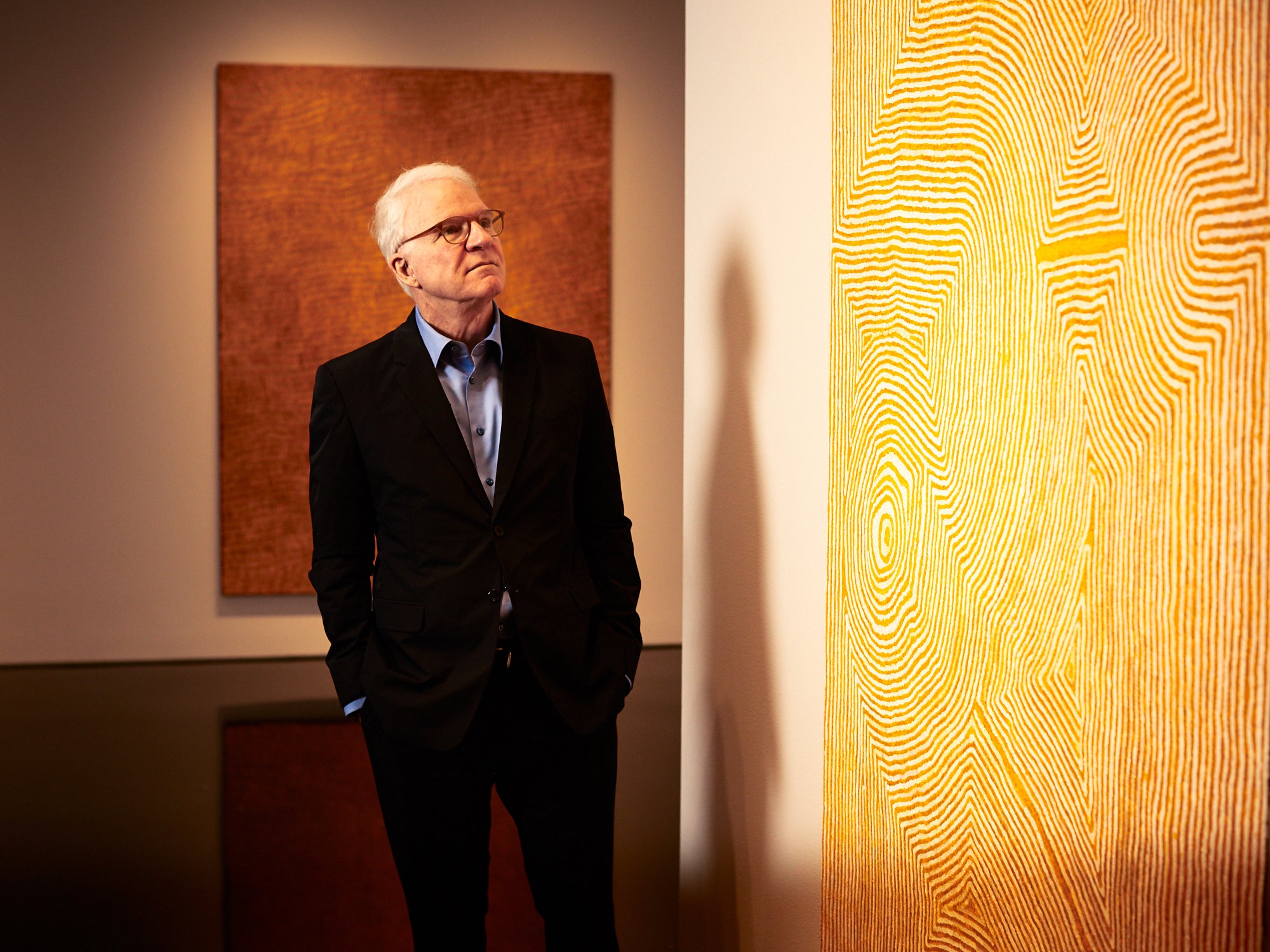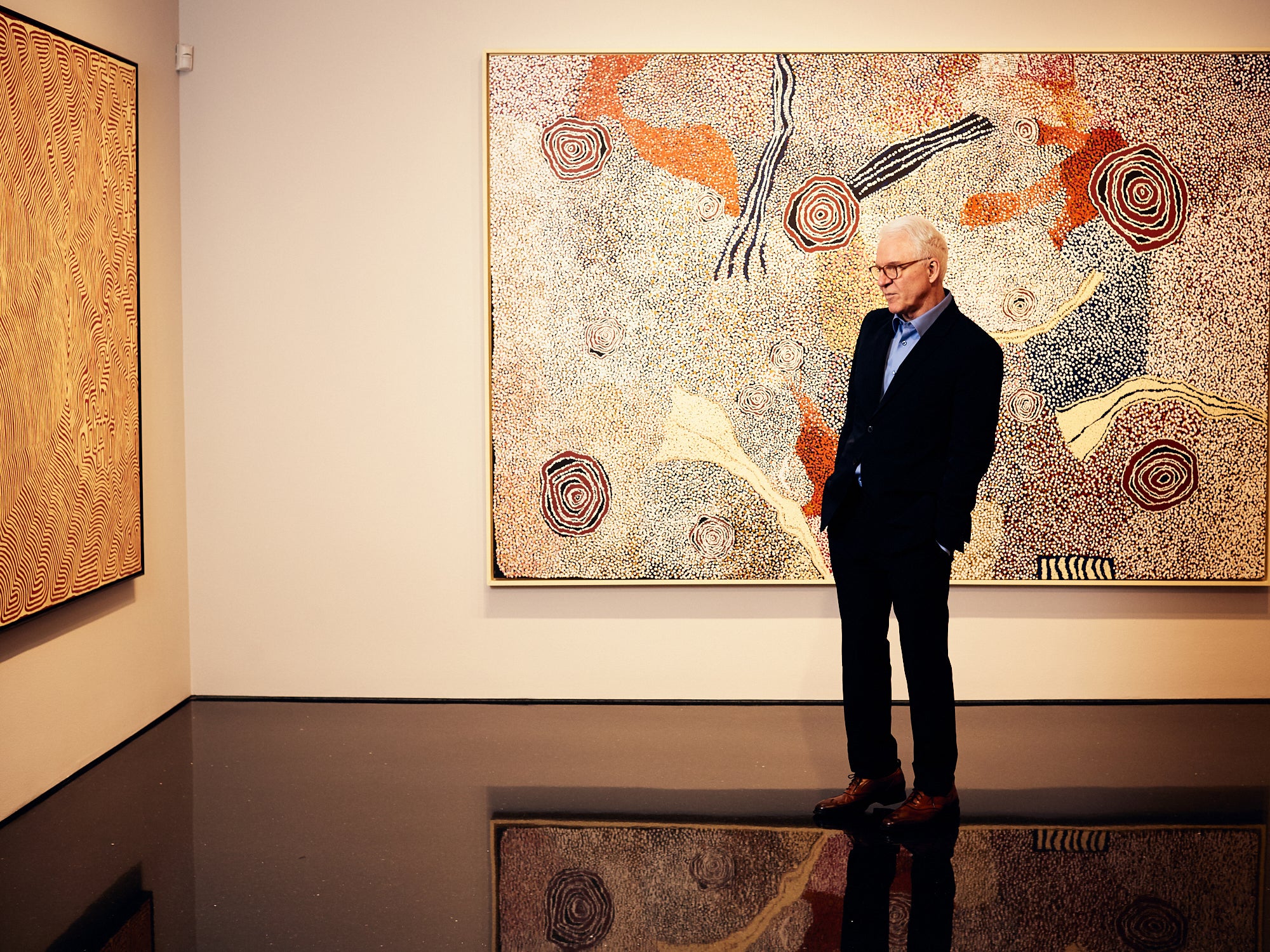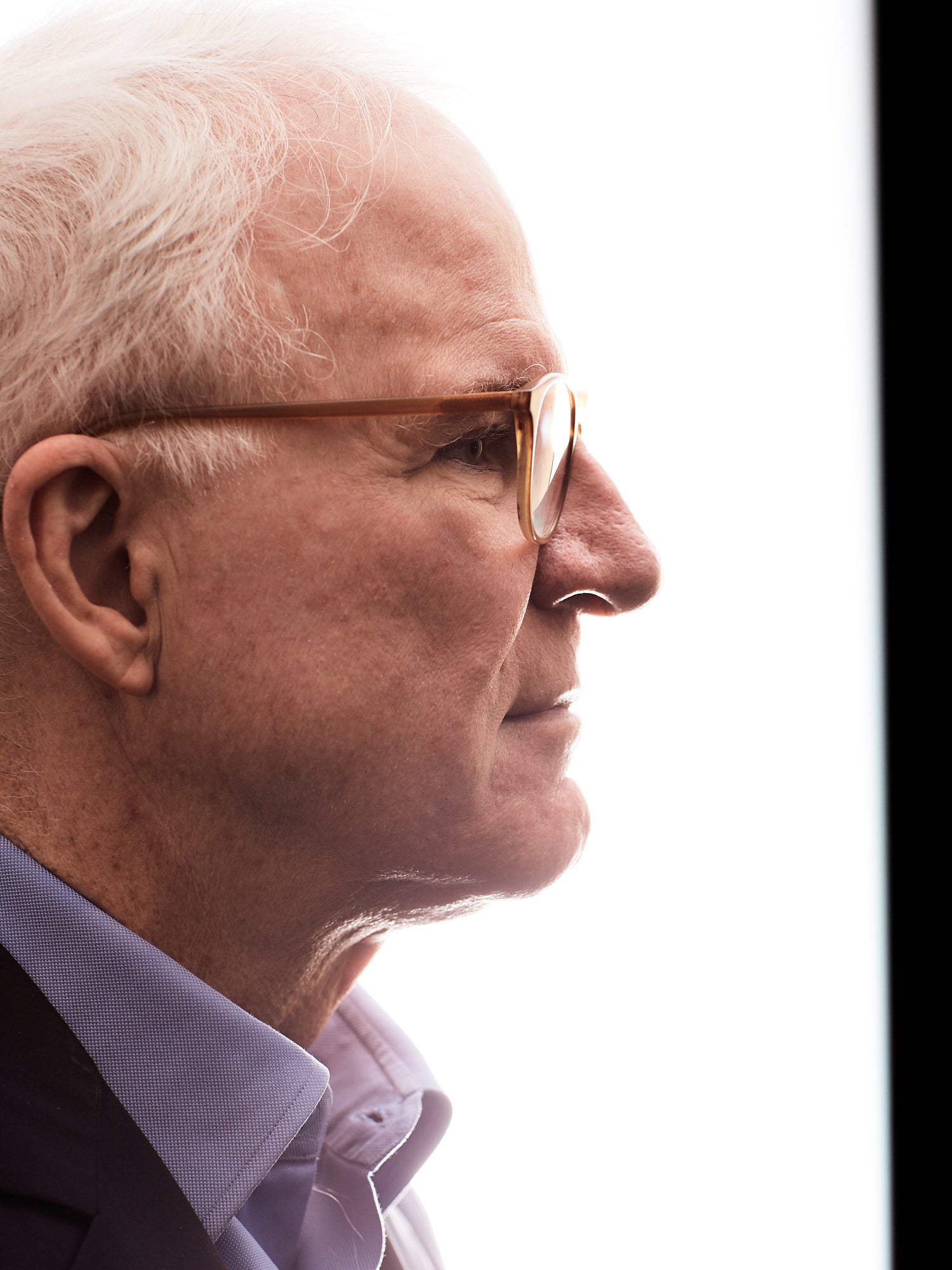Steve Martin, the unexpected advocate for Aboriginal art
The internationally renowned comic, writer and art collector, discusses his newly discovered love of Aboriginal artwork, and his New York Aboriginal art show, with Sebastian Smee

Your support helps us to tell the story
From reproductive rights to climate change to Big Tech, The Independent is on the ground when the story is developing. Whether it's investigating the financials of Elon Musk's pro-Trump PAC or producing our latest documentary, 'The A Word', which shines a light on the American women fighting for reproductive rights, we know how important it is to parse out the facts from the messaging.
At such a critical moment in US history, we need reporters on the ground. Your donation allows us to keep sending journalists to speak to both sides of the story.
The Independent is trusted by Americans across the entire political spectrum. And unlike many other quality news outlets, we choose not to lock Americans out of our reporting and analysis with paywalls. We believe quality journalism should be available to everyone, paid for by those who can afford it.
Your support makes all the difference.You could start this story in Australia’s Gibson Desert in 1984. Or you could start it in Steve Martin’s Upper West Side apartment in 2015. It really doesn’t matter. The remarkable part is simply that these two times and places came together at all.
But OK. Late summer 2015: comedian Steve Martin, who has just celebrated his 70th birthday, is at home reading the fine arts section of The New York Times. Besides his careers in comedy, acting, writing and banjo-playing, Martin – it is well-known – is a serious art lover. In the apartment he shares with his wife, Anne Stringfield, there are paintings by Francis Bacon, Lucian Freud and David Hockney, and an array of major American moderns, including Edward Hopper. But Martin is more than just a collector. He wrote a novel set in the contemporary art world and a play set in Montmartre, France, in Picasso’s day. Most recently, he was even the curator of an acclaimed travelling museum show.
So it’s no great surprise that Martin is reading the art reviews. But on this particular day, there’s a story about something he has never seen before – art by an Australian Aboriginal artist in his late 50s who is having his first solo show in New York.
Martin is so struck by the story that he gets on his bicycle – it’s a hot day – and rides downtown to Salon 94, a commercial gallery on the Bowery.
The show is filled with big paintings by Warlimpirrnga Tjapaltjarri, each in a pared-down, minimalist palette. Their asymmetrical patterns of parallel dotted lines seem to ripple and hum as they shift across the canvas. Martin is dazzled. He buys one of the paintings and hangs it near the Bacon and the Freud. It’s bigger than both of them. He’s not sure what to make of it.

At this juncture in his life, and despite having just entered his eighth decade, Martin isn’t exactly idle. Bright Star, the musical he wrote with singer-songwriter Edie Brickell, is about to open at the Kennedy Centre before heading to Broadway. He’s working on a play, Meteor Shower. He’s performing with comedian Martin Short. And oh, yeah, he and Stringfield have a 2-year-old.
But the new painting in his house has somehow got its hooks into him.
Four years later, over lunch in Manhattan, Martin tries to explain. “After a lifetime of art collecting, your eyes search for something you’ve never seen before. When you first look at [Tjapaltjarri’s work] you think it’s some kind of Op art. But it’s absolutely not. It’s an undulating landscape.”
Aboriginal art often dominates art-world discussion in Australia, and since buying that first painting, Martin (who stresses that he is by no means the first passionate collector of Aboriginal art in this country, let alone in Australia or Europe) has become a bit obsessed. He has bought more than two dozen Aboriginal paintings, has read everything he can on the subject and has solicited advice about the field from scholars and experts.
He has learned about the origins of Aboriginal painting in the 1970s, about how to understand the work – they look abstract but they’re like aerial views or diagrams that integrate narratives, both real and mythological – and about the importance of provenance.
“You go in with no education and you’re on eBay, you know, looking at things,” Martin says. “And then you start to educate yourself. There is so much well-written history on the subject because it essentially started in 1970, and so people are alive who were there. There’s documentation that I love, like, ‘And then they painted 70 paintings and we put them in a Toyota and we drove to Alice Springs, and we took to them to this place, and that’s inventory X.’”
Martin, 73, has learned all kinds of details, such as that Aboriginal paintings are painted on canvases on the ground. “Which means any which way is up,” he explains. “They move around and they move the canvas around.
“We have a picture at home by Emily Kngwarreye (the most acclaimed Aboriginal artist), which has dog prints on it. One of the dealers said, ‘Yeah, I was there.’ He said, ‘The dog walked across it – and she couldn’t have cared less.’”
Martin’s deepening preoccupation is being noticed back in Australia. And it is beginning to have tangible effects here in the United States.
In January, Martin rented two rooms at Uovo, an art storage facility in Queens. He hung the paintings he had bought, taking care over their placement and lighting. The two galleries were hushed and serene, like little chapels. Accompanying the show was a slim catalogue, with a supremely clear-eyed introductory essay by Martin.
He was curious to see how the work looked, because he hadn’t seen some of it since acquiring it. But Martin also was eager to show others. He invited a small number of art-world people and went to Queens to meet anyone who accepted.
One of those people was Yukultji Napangati, 49. She and Tjapaltjarri (who painted the first work Martin bought) were part of the so-called Pintupi Nine or “first contact group” – an indigenous group that wandered the desert living a traditional existence and that only came into contact with Australian society in 1984.
“That story,” says Martin, “killed me. Killed me.”
Earlier this year, Yukultji and her daughter dined with Martin in his apartment. But in 1984, she was a lean adolescent girl with closely cropped hair wearing only a traditional belt of hair around her waist. She had never seen white people, and her entire life had been spent moving around a small area of the Gibson Desert.
A prolonged drought meant the group was running out of food and water, and the adults were running out of appropriate mates. So two of them, including Tjapaltjarri, started searching for other Pintupi. They came across a broken-down Landcruiser and approached two clothed men, a father and son (both Aboriginal) from a remote community at nearby Kiwirrkurra, to ask for water.
Part of what fascinates Martin about Aboriginal art is what he calls its ‘lack of irony’. Unlike a lot of contemporary art, he says, ‘there is no question of it being either safe or daring. The work is directly proportionate to the emotions of the artist’
It was a tense situation. Tjapaltjarri, who was naked, carried a long spear. The father was filling a bucket with water when his son suddenly became afraid and fired his shotgun in panic. Everyone scattered.
The next day, after news of the encounter had spread through Kiwirrkurra, members of the community went looking for the lost group. “They said, ‘We’re your family, do you want to come in?’ They made it optional,” Martin says. The offer was accepted. “And then – it’s an amazing story – two of those people became major international artists.”
When Yukultji, who began painting in the early 1990s, came to Queens to see the show Martin had arranged, she brought along her adult daughter. Martin said that while the daughter “explained the painting and told anecdotes about the early days, Yukultji seemed to be transfixed by her own work, touching it and – it seemed to me – reliving the work’s meaning and creation. Afterwards, they came to the house and we had a great time laughing and enjoying our child. I played the banjo for her and she seemed quite taken with the music.”
Not long after the show in Queens, Martin was lunching with Larry Gagosian, widely considered to be the world’s most powerful art dealer. When Gagosian asked what he had been doing, Martin showed the dealer Aboriginal paintings on his iPad.
“And he says, ‘What’s that?’ And I said, ‘Aboriginal painting.’ And he says, ‘I want one of those.’ And then like a day later he says, ‘Let’s do a show.’”
The show at Gagosian’s Madison Avenue gallery on the Upper East Side opened this month. All the paintings were made in the past 30 years by Aboriginal painters from the central and western desert regions of Australia. One is borrowed from the Kluge-Ruhe Aboriginal Art Collection of the University of Virginia, the leading public collection of Aboriginal art in the United States; the rest belong to Martin and Stringfield. None of them are for sale.

Martin is simply hoping good things come from the show. What he’d really love (and discussions are underway) is a focused, carefully selected museum show.
“I’m sort of in favour of a small room in a great institution,” he says. “Because it’s so impactful in these small spaces. Without trying to tell the history, without being didactic, you can just go: ‘Pictures – look!’”
The hope, shared by champions of Aboriginal art in Australia, is that people will come to see these paintings on par with other modern and contemporary work, rather than cordoning them off as ethnographic art.
“I think if you stuck one up at Sotheby’s in the contemporary art sale,” Martin says, “people would go, ‘Uh-huh, it makes total sense that it would be there.’ There’s nothing wrong with it being ethnographic. But I maintain that Aboriginal art can live in the Museum of Modern Art without a special designation.
“I love the idea that prior to 1970, there was sand, body painting and carving. And then this whole download onto board and canvas comes spontaneously. I mean it’s just like, wow!”
Part of what fascinates Martin about Aboriginal art is what he calls its “lack of irony”. Unlike a lot of contemporary art, he says, “there is no question of it being either safe or daring. The work is directly proportionate to the emotions of the artist.”
Martin also likes the fact that “the ‘hot’ indigenous artists are older”.
Bill Whiskey, he says, “started painting when he was 85. Emily Kame Kngwarreye started in her 70s. Yukultji Napangati and Warlimpirrnga Tjapaltjarri continue to make great work, in some ways the best of their careers.”
Rather than falling off in quality, as some movements do after an initial flowering, the work has tended to become more refined. So this story, which has brought together desert nomads, banjo-playing comedians, billionaire art dealers and much else besides, is far from over.
Martin, in the meantime, talks as if he’s just getting started.
Desert Painters of Australia is at the Gagosian Gallery, New York, until 3 July
© Washington Post
Join our commenting forum
Join thought-provoking conversations, follow other Independent readers and see their replies
Comments